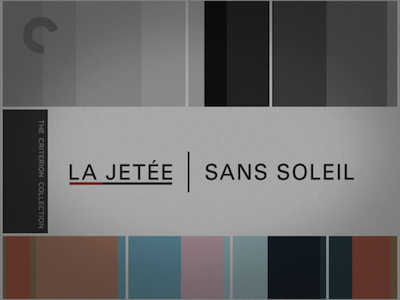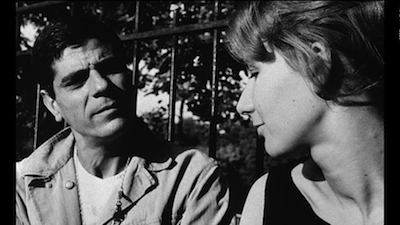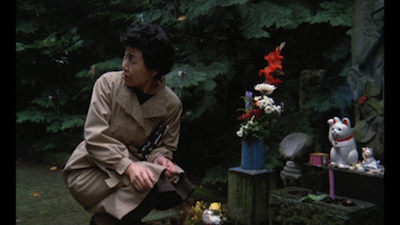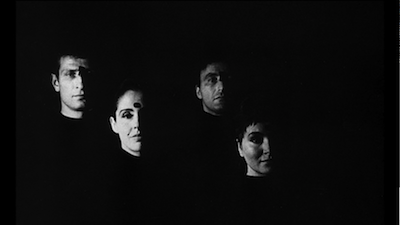It doesn’t take long into Journey to the Beginning of Time, the first movie in Criterion’s excellent Three Fantastic Journeys by Karel Zeman collection, to have cause to wonder why the pioneering director isn’t more famous. Released in 1955, the same year It Came from Beneath the Sea showcased the artistry of Ray Harryhausen, Journey to the Beginning of Time’s special effects are just as impressive, just as innovative, with Zeman proving himself a worthy successor to George Melies. Is it because his movies were aimed at children? That doesn’t stop us from liking Wes Anderson’s animated movies or Zazi dans le Metro [review]. It’s puzzling.
Karel Zeman is a Czech filmmaker who began his career in the 1940s, working on short films for the leading animation company in Czechoslovakia. Four of those early efforts are included here as bonus features, and the chosen entries already showcase a level of experimentation that is impressive, including 1949’s Inspiration--a fanciful cartoon featuring glass objects come to life. A glass blower imagines a whole world contained within a raindrop, and it invigorates his art. 1945’s A Christmas Dream similarly shows a young girl dreaming of a discarded toy dancing for her favor in a bid not to be discarded for her newer presents. Those films have live action elements, but 1946’s A Horseshoe for Luck is entirely stop motion. It was the debut of Zeman’s popular creation Mr. Prokouk (Mr. Puppet), a little man with a penchant for slapstick, and this particular short was made to encourage people to recycle their scrap for the greater good. A post-war PSA!
These extras are rounded out by the longest piece, the half-hour King Lavra from 1950. This full-color stop-motion fairy tale is based on a satirical poem--but is constructed as a silent film? Something is being lost in translation somewhere. Exquisite vintage animation, stylish puppets, but the story of a king, his unruly beard, and his rabbit ears (?!?) falls flat.
The main body of the boxed set kicks off with the aforementioned Journey to the Beginning of Time, Zeman’s second feature-length film, and it’s comparable to a Disney adventure picture or even a drive-in B-movie. Journey stars a quartet of young boys who, inspired by Jules Verne’s novel Journey to the Center of the Earth, decide to find their own pathway to the past. This is something they do easily, the way adventures begin in a lot of children’s literature, from A.A. Milne on up. Once you start out, you are there. In this case, after finding a trilobite fossil near a cave on the river, they follow the clue and sail the water into the cavernous depths, coming out the other side in the Ice Age, and traveling further back in time the closer this river takes them to the ocean. Along the way, they spot a number of prehistoric creatures fighting and eating and generally just living their lives along the banks of the water.
Zeman’s main composite trick here is to show the children in the river, with the dinosaurs in either the foreground or the background, letting distance aid in the illusion of present and past combining. In other shots, he builds larger models and puppets so the children can get closer. There is not much story here, nor much that surprises, but that simplicity aids in the suspension of disbelief. Zeman’s greatest tool is a childlike imagination, and the young actors in Journey to the Beginning of Time go a long way to selling the reality via their acceptance of their surroundings. This story is real because they believe it to be so.
In essence, Journey to the Beginning of Time is both a travelogue and a museum exhibit come to life. Each turn of the river takes us to a new diorama of the past. It’s a perfect showcase for Zeman to show off his skills, but also an educational adventure that I am sure inspired awe back in its original time, as it still remains impressive today. Younger children will still likely get wrapped up in its sense of exploration, while older viewers like me can appreciate the technique on display.
There is a definite maturation from Journey to the Beginning of Time to 1958’s Invention for Destruction. The plotting may still be simple, but the presentation is anything but, as Zeman takes his style to the next level and then to the next level after that.
Based once again on the writings of Jules Verne, Invention for Destruction tells the story of a young scientist caught up in a plot to steal benign energy technology and turn it into a terrible weapon. The narrative Zeman concocts is nothing progressive--a mentor figure is clueless to his failings, a naïve girl falls for the villain yet ends up with the hero--but the film is nevertheless something astounding to behold. I imagine this is the kind of thing that Kerry Conran intended with Sky Captain and the World of Tomorrow, a dazzling visual pulp; luckily, Zeman doesn’t get so lost in his own construction that he abandons story and character completely a la Conran. There’s just enough here to ensure Invention for Destruction is more than simply pretty pictures.
Four more years passed between Invention for Destruction and The Fabulous Baron Munchausen, time well-spent not just building the movie, but advancing Zeman’s considerable craft. The picture starts on the moon, combining practical effects with animation to create a world of pure cinematic myth, a manifestation of the titular Baron’s tall tales. Then the adventure takes us to Earth, through the palace of a sultan and onto the high seas and even into the belly of a giant fish. All the while, Zelman’s composite animation grows more seamless. There is also an added experimentation with color and sound, scenes tinted with one hue and dialogue turned to garbled brass (think the adults in Peanuts cartoons) with both restored to full clarity as story demands, that makes The Fabulous Baron Munchausen all the more dazzling.
The story is also more fun and a bit more high energy than Invention, though not nearly as high-octane as Terry Gilliam’s The Adventures of Baron Munchausen. Even if Gilliam and Zeman were not fiddling with the same source material, it would be impossible not to compare them, as Zeman is a clear influence. It’s not just the cut-out animation style that Zeman sometimes uses, or the irreverent sense of humor, but storytelling devices. His Munchausen has a tagalong witness that gets involved in the narrative expedition, just as most of Gilliam’s heroes do, right up through his most recent The Man Who Killed Don Quixote. I’d say the later filmmaker could use some of his predecessor’s restraint, but honestly, I can’t say I wish Zeman had Gilliam’s resources, because it would kill some of his resourcefulness.
It feels so rare to be charmed by movies the way I was by the ones contained in Three Fantastic Journeys by Karel Zeman. With other “fantastic journeys” seemingly just a mouse click away these days, it’s easy to forget just how imaginative and special cinema can be. Using only the physical objects at his disposal, be they paper, paint, or even flesh, Karel Zeman managed to turn the simple into the remarkable, and translate his own sense of wonder to the screen without losing an ounce of its energy. His aim was to entertain children, but he ended up striking a much broader audience...
...especially now that this collection is readily available. Getting in the spirit of their subject, Criterion have really outdone themselves with the creative packaging for Three Fantastic Journeys by Karel Zeman. Do yourself a favor and get your copy now, because the first printing comes in a fold-out cardboard case, with special die-cut pop-up designs for each movie. You’ll be sorry if you don’t.
These discs provided by the Criterion Collection for the purposes of review.
















































